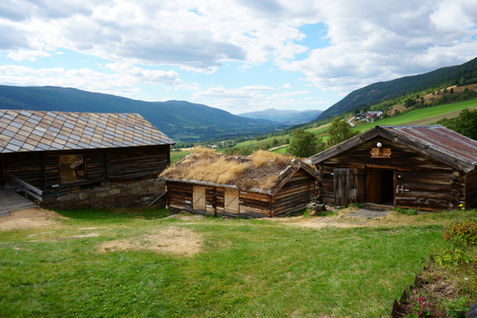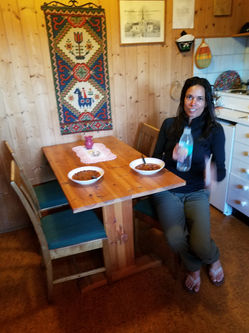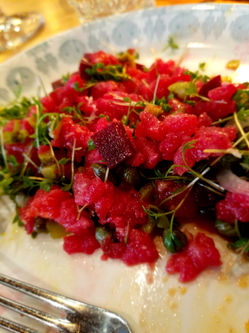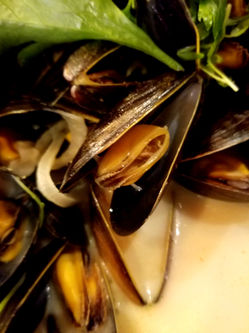Enlightened Adventures

St Olav's Way
Saint Olav's Way is a Norwegian pilgrimage route connecting Oslo to Trondheim. It's 649 kilometers of raw Norway. The trail leads through a wide variety of stunning landscapes, lakes, rivers and is encapsulated in a peaceful beauty. The route is long and sparsely populated. Careful planning is a must from gear to accommodation. (bring a tent) If you are looking to up your pilgrimage game after the Camino, this is a trail for you!
The Story
St. Olav's Way, or Pilegrimsleden, is a network of ancient pilgrimage routes leading to the Nidaros Cathedral in Trondheim, Norway. The cathedral is the final resting place of St. Olav, a Viking king who united Norway and introduced Christianity to Scandinavia.
The pilgrimage tradition to Nidaros Cathedral dates back to the 11th century when St. Olav was canonized. Pilgrims from all over Europe journeyed to the cathedral to seek blessings, healing, and spiritual enlightenment. The route offered a chance for spiritual reflection, physical challenge, and a deep connection with nature.
The Modern Pilgrimage
Today, St. Olav's Way has experienced a resurgence in popularity. While the original motivation of seeking religious salvation has evolved, the desire for personal growth, adventure, and a deeper connection with nature remains.
Modern pilgrims embark on the journey for various reasons, including:
-
Spiritual Reflection: Many pilgrims use the solitude of the trail to meditate, pray, or simply contemplate life's deeper questions.
-
Physical Challenge: The route offers a challenging yet rewarding physical experience, requiring endurance, strength, and mental fortitude.
-
Cultural Immersion: The Camino offers a unique opportunity to experience Norwegian culture, history, and stunning landscapes.
-
Personal Growth: The journey can be a transformative experience, helping pilgrims to overcome challenges, build resilience, and discover their inner strength.
By embarking on St. Olav's Way, you can experience the beauty of Norway's natural landscapes, immerse yourself in its rich history, and embark on a transformative spiritual journey.
Gallery
The Hike
The Route and Its Challenges
St. Olav's Way offers several routes, each with its unique challenges and rewards. The most popular route starts in Oslo and winds its way through stunning landscapes, including forests, mountains, and serene lakes.
Challenges along the way
-
Varied Terrain: The route includes a mix of terrains, from flat paths to steep ascents and descents.
-
Weather Conditions: Norway's unpredictable weather can range from warm and sunny to cold and rainy, so it's essential to be prepared for all conditions.
-
Remote Locations: Some sections of the route pass through remote areas with limited services, so it's important to plan accordingly and carry essential supplies.
Planning Your Pilgrimage
To prepare for your pilgrimage, consider the following:
-
Fitness Level: Ensure you have a good level of physical fitness to handle the demands of the journey.
-
Equipment: Pack lightweight, waterproof gear, sturdy hiking boots, and a backpack with essential supplies.
-
Accommodation: Book accommodations in advance, especially during peak seasons. Options range from hostels and guesthouses to campsites.
-
Food and Water: Carry enough food for several days and water for at least one. Many sections of the trail traverse through very remote areas. Finding food daily can be difficult. Stock up when you find resupply points along the way.
-
Guidebook and Map: A reliable guidebook and map will help you navigate the route and plan your daily stages.
The Journey Begins: Oslo to Lillehammer
The pilgrimage typically starts in Oslo, the vibrant capital of Norway. From here, the route winds through picturesque countryside, passing through charming towns like Hønefoss and Gjøvik. As you continue, you'll encounter the serene landscapes of Lake Mjøsa, Norway's largest lake.
The Dovre Mountain Range
One of the most challenging and rewarding parts of the pilgrimage is the crossing of the Dovre Mountain Range. This section offers breathtaking views of snow-capped peaks, glacial valleys, and crystal-clear lakes. The historic Dombås Station, a popular stopover for pilgrims, is a good place to rest and replenish your energy.
The Trondheim Region
After crossing the Dovre Mountains, the route descends into the Trondheim region. Here, you'll encounter the picturesque town of Oppdal, surrounded by majestic mountains and lush forests. As you approach Trondheim, you'll pass through the charming villages of Berkåk and Støren.
The Final Destination: Trondheim
Trondheim, the final destination of the pilgrimage, is a historic city with a rich cultural heritage. The Nidaros Cathedral, the final resting place of St. Olav, is the heart of the city. The cathedral's magnificent architecture and stunning stained-glass windows are a testament to its historical significance.




St Olav's Way is a remarkable journey full of many unseen challenges. It's remoteness and tranquil scenery impart a feeling within that will stay with you long after you've gone home.
If you would like more information or have any questions contact us at
Enlightened-Adventures
We will get you there!
Food & (lack of) Wine
Food and Drink Along St. Olav's Way
While the journey along St. Olav's Way is primarily a spiritual and physical experience, Norwegian cuisine and beverages can enhance your pilgrimage. Here are some local delicacies and drinks to look forward to:
Local Delicacies
-
Røkt laks: Smoked salmon, a Norwegian delicacy, is often enjoyed as a starter or a main course.
-
Kjøttkaker: Meatballs typically served with mashed potatoes, gravy, and lingonberry jam.
-
Fiskekaker: Fish cakes, made from whitefish, are a popular dish, often served with mashed potatoes and vegetables.
-
Fårikål: A hearty stew made with lamb and cabbage.
-
Lefse: Thin, flatbread often served with butter, brown cheese, or jam.
-
Smørbrød: Open-faced sandwiches with various toppings, such as smoked salmon, cheese, or meat.
Beverages
-
Norwegian Beer: Norway has a growing craft beer scene, offering a variety of styles, from lagers to IPAs.
-
Aquavit: A strong, flavored spirit, often enjoyed as a shot or mixed into cocktails.
-
Coffee: Norwegians love their coffee, and you'll find plenty of cozy cafes along the way.
-
Hot Chocolate: A warming drink, perfect for cold winter days.
Note: While you may encounter these dishes and drinks in restaurants and cafes along the way, it's recommended to pack your own food and snacks, especially for longer stretches of the pilgrimage.
FAQ's
Basic Questions
-
What is St. Olav's Way? St. Olav's Way, or Pilegrimsleden, is an ancient pilgrimage route leading from Oslo to Trondheim, Norway. It's a journey through stunning landscapes, rich history, and spiritual significance.
-
How long is the St. Olav's Way? The full route from Oslo to Trondheim is approximately 640 kilometers (400 miles).
-
How long does it take to walk St. Olav's Way? The average walking time is around 4-6 weeks, depending on your pace and the number of rest days you take.
-
When is the best time to walk St. Olav's Way? The best time to walk is during the summer months (June to August) when the weather is mild and the days are long.
Planning Your Pilgrimage
-
Do I need to book accommodation in advance? It's recommended to book accommodation, especially during peak seasons, to ensure availability, particularly in popular areas like Dombås and Trondheim.
-
What should I pack for the pilgrimage? Pack lightweight, waterproof gear, sturdy hiking boots, a backpack with essential supplies, a first-aid kit, and a map and guidebook.
-
How much money do I need for the pilgrimage? The cost of the pilgrimage can vary depending on your accommodation, food, and transportation choices. This pilgrimage is nothing like the Camino de Santiago. Norway is very expensive in comparison.
-
Can I walk St. Olav's Way independently? Yes, you can walk the route independently. However, guided tours can offer additional insights and support.
Walking the Pilgrimage
-
How many kilometers should I walk each day? Most people walk between 20-30 kilometers per day. However, you can adjust your daily distance based on your fitness level and preferences.
-
What should I eat on the pilgrimage? Norwegian cuisine offers a variety of hearty dishes, including fish, meat, and potatoes.
-
What should I do if I get injured or sick on the pilgrimage? If you experience a minor injury, you can visit a local pharmacy or clinic. For more serious issues, seek medical attention at a nearby hospital.
-
What happens when I reach Trondheim? Upon reaching Trondheim, you can visit the Nidaros Cathedral, the final resting place of St. Olav. You can also explore the city's historic center and enjoy its cultural offerings.
Additional Tips
-
Stay hydrated: Drink plenty of water throughout the day.
-
Protect your feet: Wear well-fitting, comfortable shoes and use blister prevention techniques.
-
Take rest days: Incorporate rest days into your itinerary to allow your body to recover.
-
mbrace the experience: Enjoy the journey, meet fellow pilgrims, and savor the beauty of the Norwegian landscape.
















































